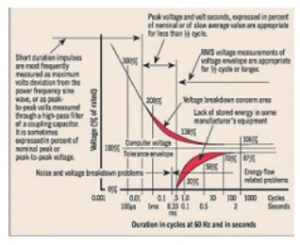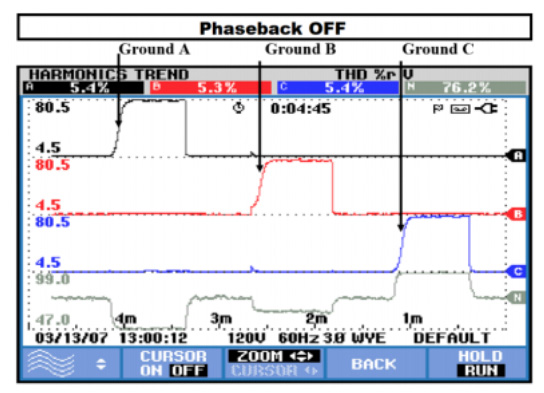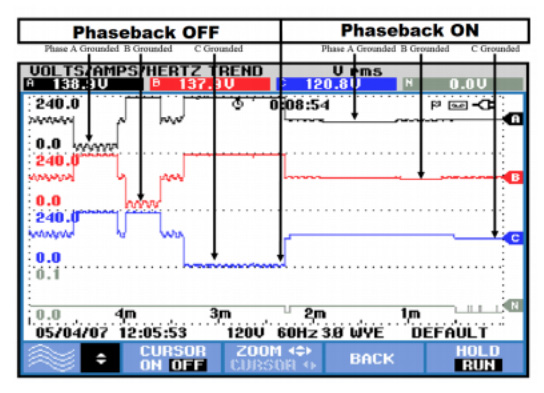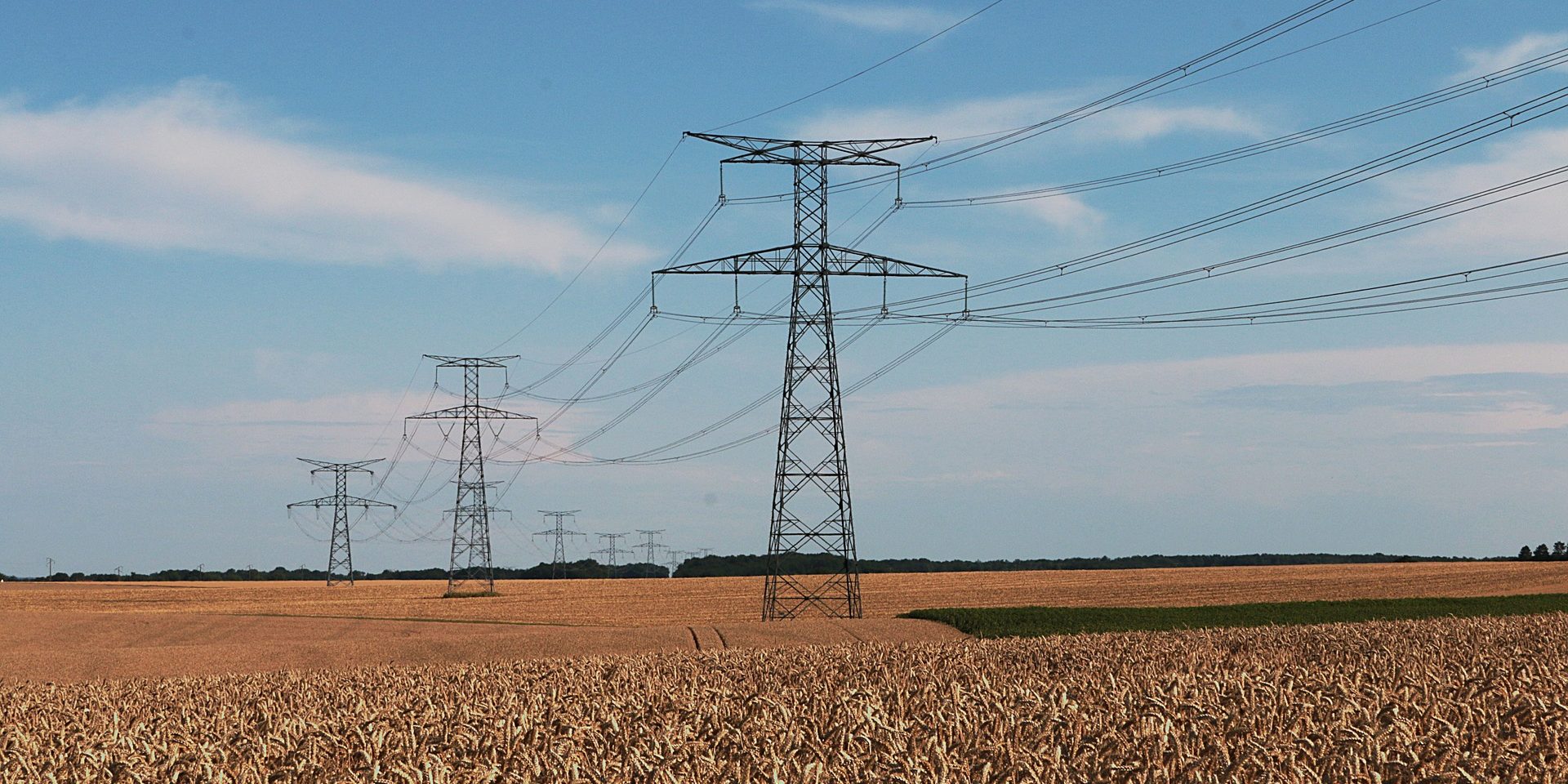William Hinton Director of Engineering for Applied Energy LLC
Daniel Princinsky President of Applied Energy LLC
Applied Energy’s Phaseback Voltage Stabilizing Ground Reference (VSGR) provides the world’s first and only complete method of power monitoring and power quality control. In 3-phase power systems, it will suppress all unwanted changes in voltage, thus preventing voltage imbalance events. Combined with other insidious power quality events that are harmful to HPC equipment, can drastically affect production runs and can be dangerous to electricians working in the data center.
At the moment of a voltage imbalance between phase and ground, the VSGR provides a phase voltage equalization to keep voltages equal within 1 to 2 volts. Additionally, if phase angles are not equal, the VSGR provides a correction to provide equal phase angles for each phase voltage. Harmonic distortion also becomes a non-issue: the VSGR is a proven means of reducing phase voltage harmonics at all frequencies.
The VSGR has also been tested against arc flash events. At a high-power test laboratory, the VSGR was connected in parallel with an operating 480 volt 3-phase load power circuit. The circuit was hit with voltages ranging from 2,500 to 8,400 volts for a duration 750 times longer than an SPD is tested for. There was no arc flash, nor was any damage dealt to the VSGR, the operating 3-phase load, or the power transformer powering this circuit. All voltages stayed within the CBEMA curve in every test in 2017 when the VSGR was in the circuit.
In a 3-phase power circuit, power quality problems can only be prevented by instantly and continuously equalizing the voltages between phase and ground. Testing data has proven the VSGR will produce the following results at the speed of the flow of current (186,000 miles per second):
- Reduce harmonic energy by 85%
- Correct phase angle distortion from >12 degrees to ±1 degree
- Correct phase to ground voltage imbalances from >20% to within 1%
In the case of many competing Power Quality devices such as insulation monitors, ground detectors, HRG, NGR, ZIG-ZAG, and SPD devices, there is a delay until the voltage builds up to the clamping voltage level, as well as a reaction time. Even if this reaction time were only 1/100th of a second, the spike in voltage could travel 1,860 miles by the time these devices provide a reaction. These competing products are not designed to react at the speed of the current flow, meaning they are designed to delay in their reaction before attempting to control the voltage waveform.
Examples of Voltage Imbalance
 At the beginning of a transient electrical event, a Surge Protective Device (SPD) will ignore overvoltage occurring phase-to-ground: it is allowing a voltage imbalance to occur. When a transient surge of voltage has reached the SPD’s clamping level, the SPD sends thousands of amps of fault current to the ground, which is the reference point for computers and controls.
At the beginning of a transient electrical event, a Surge Protective Device (SPD) will ignore overvoltage occurring phase-to-ground: it is allowing a voltage imbalance to occur. When a transient surge of voltage has reached the SPD’s clamping level, the SPD sends thousands of amps of fault current to the ground, which is the reference point for computers and controls.
The CBEMA curve shows overvoltage damage and dropout points in a range of operating voltages based on time. When voltages are held inside this curve, electrical systems will operate longer and more reliably, without risk of damage:
- Phase voltages must be no more than 10% out of balance
- Phase voltage vectors should be less than 5 degrees out of balance
- Phase voltage must not spike or drop beyond system tolerance
Phase voltage vectors are considered balanced at an offset of exactly 120 degrees (360 degrees divided by 3). When this holds true in a power system, the line voltage is equal to the phase voltage with respect to ground multiplied by 1.732. When the vectors are not separated by 120 degrees, this does not measure or calculate correctly and is not correct in most power systems.
The solution to an unreliable power system is found in the same place we look to address and solve electrical noise: the phase to ground voltages. When collecting power quality data, phase to the ground is also the best place to set up your power quality meter. The causes of power issues are the same across any industry or application. Without testing, it is unknown whether there is a voltage spike issue, a voltage or current harmonics issue or a vector displacement issue, or whether it is a problem that occurs at system start-up or shut-down.
Harmonic distortion with a phase to ground voltage imbalance

Prevent Arc Flash with Phaseback VSGR
The prevailing opinion states that mitigation is an electrician’s best option when looking to prevent arc flash events. Commonly proposed solutions include “fast-acting” relays whose purpose is to de-energize the circuit breaker, hopefully mitigating the arc flash event. All of the present methods to address and minimize the damage and danger from an arc-flash can’t start helping until AFTER the event has begun.
In consideration of employee safety, this “fast-acting” approach is not fast enough, and cannot guarantee results. Arc flash events must be prevented or instantly suppressed. This requires a device that can correct power quality problems without any delay.
Voltage Control: Why It Matters
In order to adequately resolve power quality problems such as arc flash events, the solution must operate fast enough to engage simultaneously with the cause and effect of the problem. Otherwise, the power system is forever a step behind, and true prevention of the event is not achieved.
Because voltage causes current and not vice versa, it is obvious that controlling voltage is a faster and more effective means of correcting issues with power quality. The Phase back VSGR uses voltage control, and via laboratory testing and multiple field applications, it has been proven to prevent arc flash events from occurring.
While current-driven devices counter a voltage imbalance with a separate and disproportionate current imbalance, the Phaseback VSGR corrects phase voltage imbalances using the energy caused by the voltage imbalance, also known as event energy.
 By using the energy of the event, Phase back VSGR uses thousandths of an amp instead of the hundreds or thousands of amps used by other inferior methods. The energy supplied from the high phase voltage is directed 180 degrees out of phase with the low phase voltage. This is back voltage: a quantity of voltage supplied back into the low voltage phase. It is this voltage-driven approach that allows the Phaseback VSGR to correct power quality problems simultaneously as they manifest.
By using the energy of the event, Phase back VSGR uses thousandths of an amp instead of the hundreds or thousands of amps used by other inferior methods. The energy supplied from the high phase voltage is directed 180 degrees out of phase with the low phase voltage. This is back voltage: a quantity of voltage supplied back into the low voltage phase. It is this voltage-driven approach that allows the Phaseback VSGR to correct power quality problems simultaneously as they manifest.
Simultaneous Suppression: Protection with a Payback
Preventing phase-to-ground voltage imbalance is the key to good power quality. The CBEMA curve indicates the limitations and tolerances of equipment, and voltages must be kept within this tolerance. With VSGR, even the most sensitive electronic equipment will operate efficiently and reliably at the center of the CBEMA curve.
When phase voltages are balanced with the Phaseback VSGR, the power system enjoys numerous benefits not available from any other power quality product. The VSGR will simultaneously suppress the following events automatically, reliably, and economically:
- Arc flash events
- Voltage imbalance
- Voltage harmonics
- Transient voltage spikes
Other technologies cannot compete: the VSGR provides real-time corrections for all power quality problems at the beginning of an event and will continue to do this for over 35 years, even in environments with high electrical noise. Applied Energy’s policy is to provide “Protection with a Payback”: The resulting clean power provided by Applied Energy LLC’s patented products will generally result in payback or ROI of less than 1 year.
Phaseback VSGR Corporate Brochure:
https://phaseback.com/wp-content/uploads/2018/06/Phaseback_VSGR_Brochure_January_2018-1.pdf
Phaseback VSGR Operation, Installation & Maintenance Guide:
http://phaseback.com/wp-content/uploads/2018/08/Phaseback-Manual_2018_08_23_1516.pdf
Video Section with live demonstrations of our products:
https://phaseback.com/videos/
Download Section with examples, manuals, and support information: https://phaseback.com/downloads/
The Phase back VSGR carries a lifetime warranty. It was designed, developed, tested for over 19 years, manufactured, and patented by Applied Energy LLC. Patent reference at the USPTO: 10,985,648 B2 (SYSTEMS AND METHODS FOR POWER MONITORING AND CONTROL)
If Phaseback isn’t already installed in your facility, ask your manager: Why not?
For contact and product information, including test results, visit us at www.Phaseback.com
To get your facilities protected, contact one of our authorized representatives at: https://phaseback.com/contact-us/

